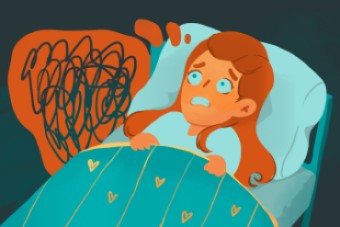Generalized anxiety disorder (GAD) is quite common, about three percent of the population has this disorder. GAD is different from other anxiety disorders. In GAD, the disorder is not bound to a specific situation or a fear of having a panic attack.
GAD is characterized by non-stop general worry, tenseness, and extreme agitation about ordinary events in the future (work, study, financial well-being, interpersonal relationships) or improbable events.
Despite anxiety being a special trait of GAD, various mental symptoms characteristic of other forms of anxiety are less widespread in this disorder. The major symptoms are volatile, even though constant nervousness, fever, muscle tension, nausea, dizziness, and discomfort in the epigastric area are usually the most popular complaints.
Very often the patient feels afraid that they or their loved ones will soon get sick or become a victim of an accident.
Symptoms:
- extreme anxiety and worry about various life situations or events.
- patients struggle to control the anxiety which is present in more than half of the days for more than six months.
- when experiencing anxiety, there are more than three of the following symptoms:
- emotional anxiety, agitation, or nervousness
- easy fatigability
- struggle with an attention span
- irritability
- muscle tension
- anxious sleep
Mixed anxiety and depressive disorder
Mixed anxiety and depressive disorder are characterized by symptoms of both anxiety and depression, which are present most of the time for two weeks and more.
Depressive symptoms include depressed mood and a very noticeable loss of interest and enjoyment from activities that used to bring happiness and/or joy.
Multiple symptoms of anxiety can be feeling of nervousness, uneasiness, or “being worked up”; inability to control worrisome thoughts, fear of something terrifying happening; inability to relax; muscle tension.
Neither depressive nor anxiety symptoms separately are not distinct, vast, or long-lasting enough to be diagnosed as a depressive disorder or a disorder associated with anxiety or fear. Symptoms lead to strong subjective distress or significant disturbances in personal, family, social, educational, professional, and other crucial areas of functioning.
Manic or mixed were not noted previously.
Among the symptoms of mixed anxiety-depressive disorder these are notable:
- occurrence of anxiety or worry on different occasions
- aggressiveness and irritability
- easy fatigability, excessive weakness
- depressed mood or rapid change of it, low mood most of the time
- distractedness, inability to concentrate
- troubles with sleep
- emotional lability, tearfulness
- pessimism, feelings of hopelessness
- low self-esteem, the feeling of futility, uselessness
Reasons for the mixed anxiety-depressive disorder can be various, following factors are major among the others:
- Sudden change in the life status-quo (switching jobs, change of marital status, etc)
- Prolonged stress
- Troubles in family relationships, conflicts at work
- Negative events (death, illness)
- Genetic predisposition
- Person’s own traits
